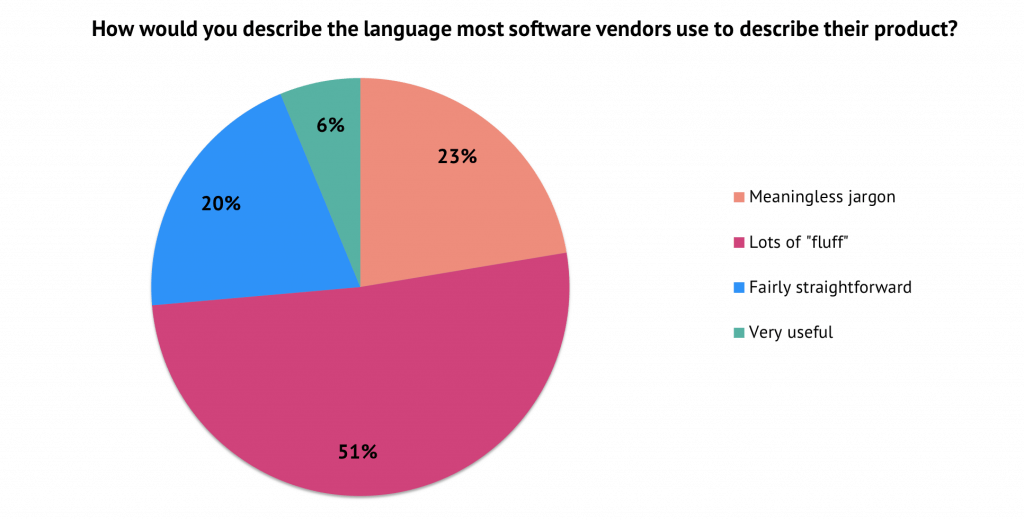
74% of Buyers Don’t Like Your Messaging — Here’s How to Fix It
If you work in tech marketing, you have probably also researched or purchased marketing tech for your company. So you might be familiar with this experience:
“I can read the entire website of a software company and still have no clue what their products actually do.”
This quote came from our latest Software Buyer Poll. We asked 769 software buyers what they think of the way vendors describe their products. The results are astounding: 3 out of 4 buyers described vendor marketing language as either meaningless jargon or lots of “fluff.”

Source: Software Buyer Poll, May 2018
“80% of all language used to describe software products is meaningless.”
The buyer above was speaking from their own anecdotal experience, but the made-up stat isn’t far off from our own results. Many of the surveyed buyers passionately and creatively described what they dislike about vendor messaging:
“They overuse words that have no basis in any factual information, ‘industry standard,’ ‘best in class,’ ‘award winning’
“Prolific regurgitation of trending buzzwords”
“It’s word salad with no clear benefit or value proposition.”
“It’s like their marketing team got drunk with a buzzword dictionary and had a baby”
“It forgets that there are humans on the other side who need to read these buzzwords, and then use valuable brain resources to process their meaning”
“‘It does some great stuff by magic’ would summarize most marketing.”
These buyers aren’t mincing words. They are clearly frustrated that they have to pick through a lot of BS to get the information they need from you. And that’s not good for buyers or vendors. This disconnect in communication style costs both of you actual time and money. So how can marketers do better?
Let’s unpack the most common complaints buyers have about your messaging, and how you can address them.
Problem #1: Vague promises that skip “how”
One of the most common complaints is that messaging focuses solely on an idealistic end result. Buyers recognize that vendor marketers are trying to sell their product, often to the executives who will ultimately sign the check. But this can lead to over-simplified language, where you’re making a bold claim to excite the reader without following up with details. So buyers involved in the hands-on evaluation are left wondering what your product actually does.
“Lots of business impact terms, revenue, leads etc but no reason to believe that impact.”
“Meant to excite executives, not meaningful for end users or technical experts”
“I find most don’t describe the actual functions and instead talk about increasing revenue without talking about how.”
“It seems as though vendors are selling a solution, and you’re left trying to figure out if you have the right problem.”
Buyers need some substance behind your high-level value proposition, so that they can figure out if your product actually meets their need.
Solution: Answer these key questions
Read back over your copy, and make sure you answer the key questions buyers usually have:
- Who is this for?
- What business problem does it solve?
- How does it solve that problem?
- What business outcome does it aim to drive, and what specific approach does it take?
Provide concrete evidence or examples where customers achieved the promised outcome. Steer clear of vague terms, and opt for specific ones. Here’s a great example of how to do it right from a buyer:
“They can use technical terms if they are used for efficiency and sparingly. I would rather have that than puffery. “A global, rapidly changing, world-class, innovative” solution for businesses. That would be useless. But saying a lifecycle HCM Software as a Service for SMBs and integration with payroll and benefits providers would be perfectly clear.”
If your elevator pitch could apply to a different type of solution, or even to one of your competitors, it probably isn’t specific enough for your buyers.
Problem #2: Inflated or unprovable claims
The second biggest complaint from buyers was that vendor messaging is often over-selling, with claims that are unbelievable, unprovable or simply not true. Buyers want to hear how your product is different from alternatives, but they aren’t fooled by exaggerated claims, and they know the road to success won’t be all sunshine and rainbows.
“Vendors are usually talking about the product as if it is going to take over the planet.”
“Everyone seems to be the ‘leading provider’ still, after all these years.”
“They are ‘Selling their Vision’ which means that they are overselling their software capabilities.”
“Lots of complex software products emphasize shiny business outcomes but withhold the fact that the path to those results can be a rollercoaster, entailing lots of stress and unplanned costs.”
“Often the functionality of software is pretty basic, or fairly easy to understand, but this does not necessarily sell well – so the marketing team inflates the software product into being something that it is not, and in the process, makes it much harder to understand what the product actually does, and what it doesn’t do.”
Solution: Keep it real, and let your customers use the adjectives
There are some adjectives we should all just remove from our vocabularies, like industry-leading, best-in-class, world’s best, award-winning, cutting edge, and state of the art. If there’s evidence behind those statements, just present that evidence and let it speak for itself (i.e. awards you’ve won, or specific areas where your product shines above the rest).
But also read the promises you’re making with a discerning eye. Rarely does software change the world or enrich people’s lives — and if you say yours does, your buyers aren’t going to believe it. Instead, simply state the business outcomes your customers are achieving with your product in concrete terms rather than grandiose ones.
Better yet, get your customers to talk about the outcomes they’ve achieved in their own words. Featuring customer quotes on your website or in marketing outreach is a great way to get at that humblebrag your buyers can believe.
Problem #3: Too many buzzwords
Buyers accuse vendor marketers of using buzzwords that have no real meaning, or misusing buzzwords that do have a real meaning, but not a real connection to the product. Some buyers, IT buyers especially, feel this betrays that a marketer doesn’t really understand their own product. Other buyers say that overuse of buzzwords makes it hard to understand what a product actually does.
“Trendy words that do not match product features.”
“It is almost as if they invent words to prove how hip and smart they are but from my perspective it has the opposite effect.”
“I dislike the fact that whatever is the software product they always align their marketing message to a trend, for instance “Digital transformation”.”
“Vendors jump onto a new trend by x-washing their products. We’ve seen cloud-washing. Now I believe we’re being subjected to AI-washing: vendors branding algorithms that are not strictly intelligent as genuine AI.”
“Vendors, apart from self-adulation to the point where it becomes laughable, tend to use a mass of trendy buzzwords like ‘real-time,’ ‘omni-channel’ etc. without really telling you how they apply to their product (which often they don’t do or just barely).”
Solution: Specify how technical terms apply to your product
Some of the buzzwords buyers find most meaningless actually have a very real meaning. Examples include cloud, Internet of Things, blockchain, AI, analytics and machine learning.
Wherever you use technical terms, make sure you back them up with specifics about what they mean and how they tie to your product. Run your language by someone on the Product team to make sure you’ve got it right.
In some cases, there’s not much in the way of an industry standard, so buyers will need you to spell out what you mean:
“Most of the terms could have value but there’s no industry standard to define what it means, so it’s too vague. Optimize, insights, deep engagement… all sound great… but I’m going to have to ask you exactly what you mean by that.”
Your customers are the perfect people to help you get there. They live day to day in the application and interpretation of industry and product terms, and your buyers will likely understand what they mean — so don’t be afraid to borrow some of their language.
Problem #4: Focused on the wrong value prop
Here’s where there’s a bit of divergence in buyer feedback. Some buyers felt vendors focus too much on features and functions, without addressing how the product benefits its customers. Other buyers complained that vendors only talk about benefits, but don’t back it up with features.
“A focus on features is usually fluff and does not really show the benefit. A ton of features does not mean much if you cannot get real business benefits from them.”
“Instead of concentrating on specific features, there is loud over-statements and references to ‘business benefits’ which is even less quantifiable”
Similarly, some buyers felt descriptions are too technical, while others felt they weren’t technical enough.
“Most vendors write descriptions that only highly knowledgeable people would understand. But not all company owners know deep tech or industry stuff and it gets confusing for them rather than helpful.”
“It’s usually very fluffy and vague. As a technical person I can usually tell that it was written by someone in marketing who doesn’t really understand the product.”
Solution: Know your audience and speak their language
This complaint relates to the first on our list: talking about the outcomes you drive, without explaining how, isn’t very useful. But the reverse is true as well. Listing out all the features you provide, without starting with the business problem you’re solving for, isn’t the right approach either.
But exactly where you need to be on the feature-vs-benefit spectrum, or the technical-vs-non-technical spectrum, depends on your target audience. And you probably need to have messaging targeted at the executive buyer, as well as the technical user. Get as close as you can to both, so you understand how to speak their language.
Your customers, including all the different personas you touch within one account, can help. Use all the tools at your fingertips—reviews, surveys, in-depth interviews—to ensure you fully understand your customers and buyers.
Some vendors get it right
If you’re worried that you’ll never be speaking the same language as your buyers — don’t! There’s solid evidence showing it doesn’t have to be this way: the 26% of buyers who found vendor messaging to be straightforward or useful. This aligns with the 23% of buyers who found their vendor to be very influential in our 2018 B2B Buying Disconnect report.
To inspire you and point you in the right direction, here’s some advice straight from the mouths of buyers:
“Good descriptions say what it does, what you need for it to be useful, why it matters in real terms, and give some idea what it costs.”
“I like clear, concise language. Benefits explained simply in language I understand.”
“I need to know how their product can really help me with my challenges with everyday examples”
“Just tell me what the %$#@ thing does… and perhaps some use cases.”




